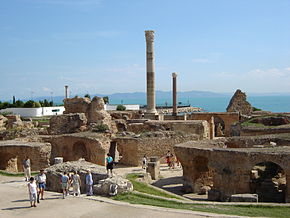Archaeological site of Carthage

Baths of Antoninus, Carthage
|
|
| Location | Tunisia |
|---|---|
| Region | Tunis Governorate |
| Coordinates | 36°51′10″N 10°19′24″E / 36.8528°N 10.3233°E |
| Designations | |
|---|---|
| Type | Cultural |
| Criteria | ii, iii, vi |
| Designated | 1979 (3rd session) |
| Reference no. | 37 |
| State Party |
|
| Region | Arab States |
Carthage (/ˈkɑːrθɪdʒ/, from Latin: Carthāgō; Phoenician Qart-ḥadašt "New City") was the centre or capital city of the ancient Carthaginian civilization, on the eastern side of the Lake of Tunis in what is now the Tunis Governorate in Tunisia.
The city developed from a Phoenician colony into the capital of an empire dominating the Mediterranean Sea during the first millennium BC. The apocryphal queen Dido is regarded as the founder of the city, though her historicity has been questioned. According to accounts by Timaeus of Tauromenium, she purchased from a local tribe the amount of land that could be covered by an oxhide. Cutting the skin into strips, she laid out her claim and founded an empire that would become, through the Punic Wars, the only existential threat to the Roman Empire until the evolution of the Vandals several centuries later.
The ancient city was destroyed by the Roman Republic in the Third Punic War in 146 BC then re-developed as Roman Carthage, which became the major city of the Roman Empire in the province of Africa. The Roman city was again occupied by the Muslim conquest of the Maghreb, in 698. The site remained uninhabited, the regional power shifting to the medina of Tunis in the medieval period, until the early 20th century, when it began to develop into a coastal suburb of Tunis, incorporated as Carthage municipality in 1919.
...
Wikipedia

